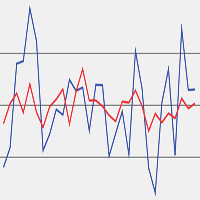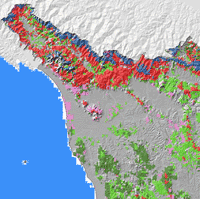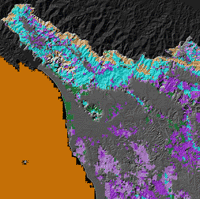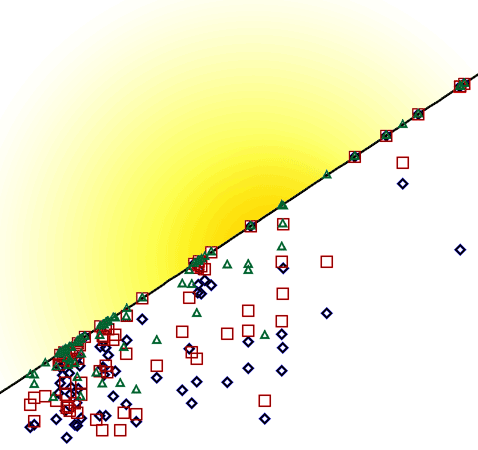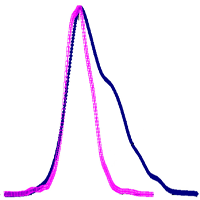
Incorporating management history into forest growth modelling
iForest - Biogeosciences and Forestry, Volume 4, Issue 5, Pages 212-217 (2011)
doi: https://doi.org/10.3832/ifor0597-004
Published: Nov 03, 2011 - Copyright © 2011 SISEF
Research Articles
Collection/Special Issue: COST Action FP0903 (2010) - Rome (Italy)
Research, monitoring and modelling in the study of climate change and air pollution impacts on forest ecosystems
Guest Editors: E Paoletti, J-P Tuovinen, N Clarke, G Matteucci, R Matyssek, G Wieser, R Fischer, P Cudlin, N Potocic
Abstract
Mechanistic modelling is an important tool for understanding the impacts of climate change and pollutants on forest growth. One of the common practical limitations of these models is a lack of specific information regarding management activities such as thinning or harvesting, which can have a very strong influence on the accuracy of results. The use of inventory data for model parameterization and calibration is also problematic, as inventories are designed to have large volumes of data amalgamated to give accurate mean results across large areas. The precision of single point estimates is often quite low.This study uses BIOME-BGC to model forest growth on 1133 sites of the Austrian National Forest Inventory, and develops a method to estimate timber removal patterns prior to the commencement of record keeping on the sites. Recognizing the poor precision of individual point estimates in the data, we do not seek to precisely calibrate the model to the data on each point. Rather, we assume that the point-wise inventory estimates will be normally distributed around the true values. We then model each site assuming no management interventions, and compare this with inventory results. Plotting the “error” between model results and NFI data shows a strong right-skew, reflecting the modelled lack of timber removals. A Box-Cox transformation of the error plot, centred on zero, would represent an unbiased model estimate of the data, thus we can determine the historic timber removals as the difference between the original error curve and its Box-Cox transformation. Calibrating the model with this information allow us to represent forest volume with greater accuracy than would otherwise be possible.
Keywords
BIOME-BGC, Inventory, Uncertainty, Thinning, Model initialisation
Authors’ Info
Authors’ address
H Hasenauer
Institute of Silviculture, University of Natural Resources and Life Sciences (BOKU), Vienna (Austria).
Corresponding author
Paper Info
Citation
Eastaugh CS, Hasenauer H (2011). Incorporating management history into forest growth modelling. iForest 4: 212-217. - doi: 10.3832/ifor0597-004
Paper history
Received: Nov 30, 2010
Accepted: Aug 22, 2011
First online: Nov 03, 2011
Publication Date: Nov 03, 2011
Publication Time: 2.43 months
Copyright Information
© SISEF - The Italian Society of Silviculture and Forest Ecology 2011
Open Access
This article is distributed under the terms of the Creative Commons Attribution-Non Commercial 4.0 International (https://creativecommons.org/licenses/by-nc/4.0/), which permits unrestricted use, distribution, and reproduction in any medium, provided you give appropriate credit to the original author(s) and the source, provide a link to the Creative Commons license, and indicate if changes were made.
Web Metrics
Breakdown by View Type
Article Usage
Total Article Views: 57789
(from publication date up to now)
Breakdown by View Type
HTML Page Views: 49119
Abstract Page Views: 3161
PDF Downloads: 4165
Citation/Reference Downloads: 28
XML Downloads: 1316
Web Metrics
Days since publication: 5157
Overall contacts: 57789
Avg. contacts per week: 78.44
Citation Metrics
Article Citations
Article citations are based on data periodically collected from the Clarivate Web of Science web site
(last update: Mar 2025)
Total number of cites (since 2011): 9
Average cites per year: 0.60
Publication Metrics
by Dimensions ©
Articles citing this article
List of the papers citing this article based on CrossRef Cited-by.
References
An analysis of transformations. Journal of the Royal Statistical Society Series B 26 (2): 211-252.
Gscholar
Biomass functions applicable to oak trees grown in Central-European forestry. Journal of Forest Science 54: 109-120.
Gscholar
The usefulness of time series angle-count forest inventory data in assessing forest growth model accuracy. Forestry Ideas 16 (2) 171-180.
Gscholar
Climate characteristics across the Austrian forest estate from 1960 to 2008. Austrian Journal of Forest Science 127 (3): 133-146.
Gscholar
Methoden der Österreichischen Waldinventur 2000/02. BFW-Berichte 135, Federal Research and Training Centre for Forests, Natural Hazards and Landscape, Vienna, Austria, pp. 135.
Gscholar
Point-sampling and line-sampling: probability theory, geometric implications, synthesis. USDA Forest Service, South Forest Experimental Station, Occasional Paper 160, pp. 34.
Gscholar
Evaluating progress towards closed forest models based on fluxes of carbon, water and nutrients. Tree Physiology 9: 1-15.
Gscholar
Modelling carbon dynamics in forest ecosystems using Biome-BGC. In: “Greenhouse gas budget of soils under changing climate and land use” (Jandl R, Olsson M eds). BFV, Wien, Austria, pp. 63-70.
Gscholar
Anvendung und Validierung des Klimainterpolationsmodells DAYMET in Österreich. MSc thesis, University of Natural Resources and Applied Life Sciences, Institute of Silviculture, Vienna, Austria, pp. 95.
Gscholar
Large scale mechanistic ecosystem modeling in Austria. Ph.D. thesis, University of Natural Resources and Applied Life Sciences, Institute of Silviculture, Vienna, Austria, pp. 135.
Gscholar
Interpolating input parameters for large scale ecosystem models. Austrian Journal of Forest Science 124 (2): 135-151.
Gscholar
Formzahlfunktionen der Hauptbaumarten Österreichs. Allgemeine Forstzeitung 85: 341-343.
Gscholar
Assessing the productivity and water regime in the Schmittenbach catchment area. Diploma thesis, University of Natural Resources and Applied Life Sciences, Institute of Silviculture,Vienna, Austria, pp. 75.
Gscholar
Potential contributions of statistics and modelling to sustainable forest management: review and synthesis. In: “Sustainable forestry: from monitoring and modelling to knowledge management and policy science” (Reynolds KM, Thomson AJ, Kohl M, Shannon MA, Ray D, Rennolls K eds). CABI, pp. 525.
Gscholar
Methode der Zuwachsberechnung der Österreichischen Waldinventur. Ph.D. Thesis, University of Natural Resources and Applied Life Sciences Vienna, Institute for Forest Growth, Vienna, Austria, pp. 99.
Gscholar
Contribution of increasing CO2 and climate to carbon storage by ecosystems in the United States. Science 287 (5460): 2004-2006.
CrossRef | Gscholar
Description of a numerical simulation model for predicting the dynamics of energy, water carbon and nitrogen in a terrestrial ecosystem. PhD thesis, University of Montana, Missoula, USA, pp. 280.
Gscholar
Auswirkungen des Klimawandels auf Österreichs Wälder - Entwicklung und vergleichende Evaluierung unterschiedlicher Prognosemodelle (WAMOD). Projektbericht 2010 (Antragsnummer A760631). BOKU, Institut für Waldbau; Institut für Waldwachstumsforschung, BFW, Institut für Waldinventur, Wien, Österreich (in German).
Gscholar

